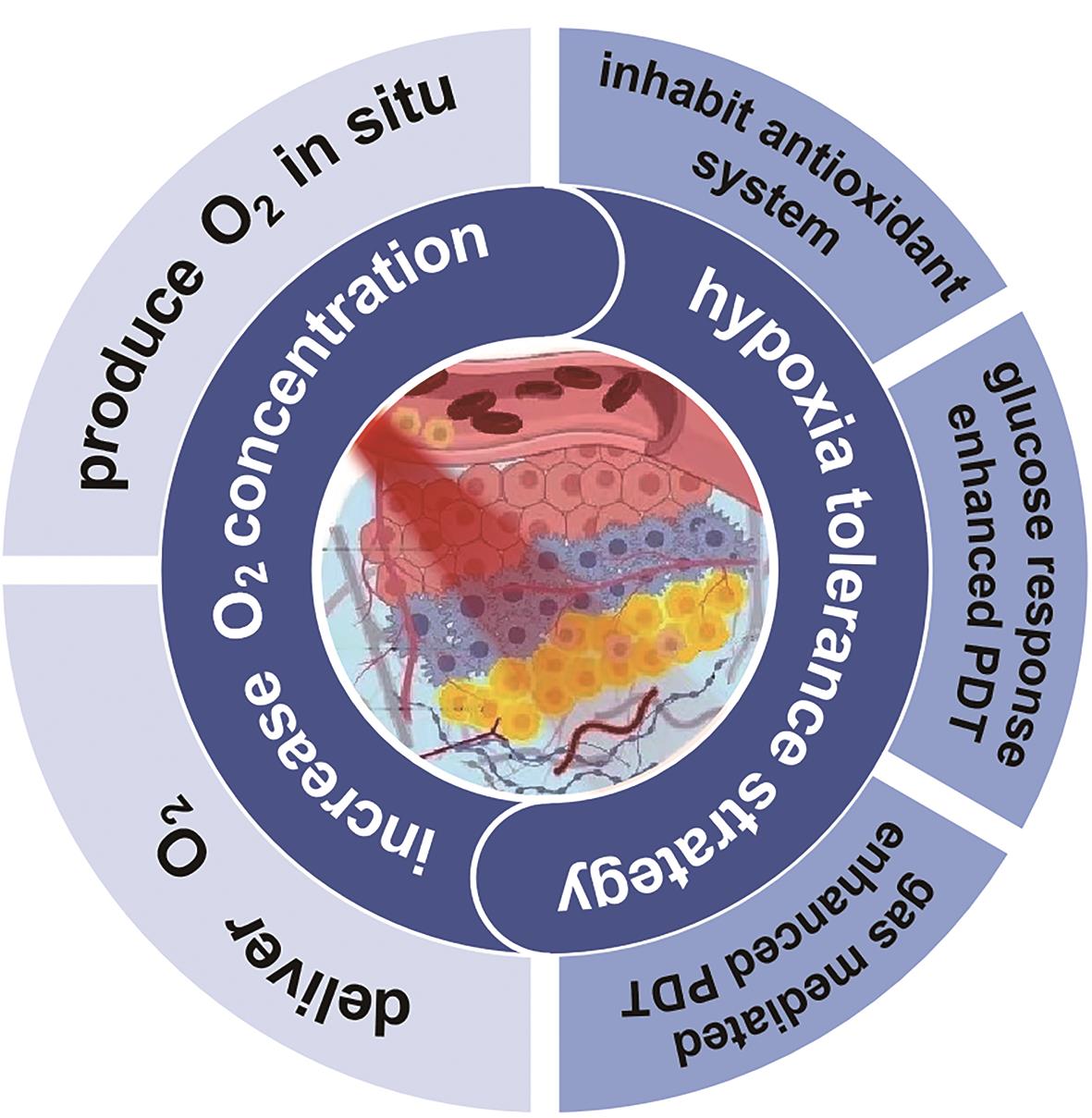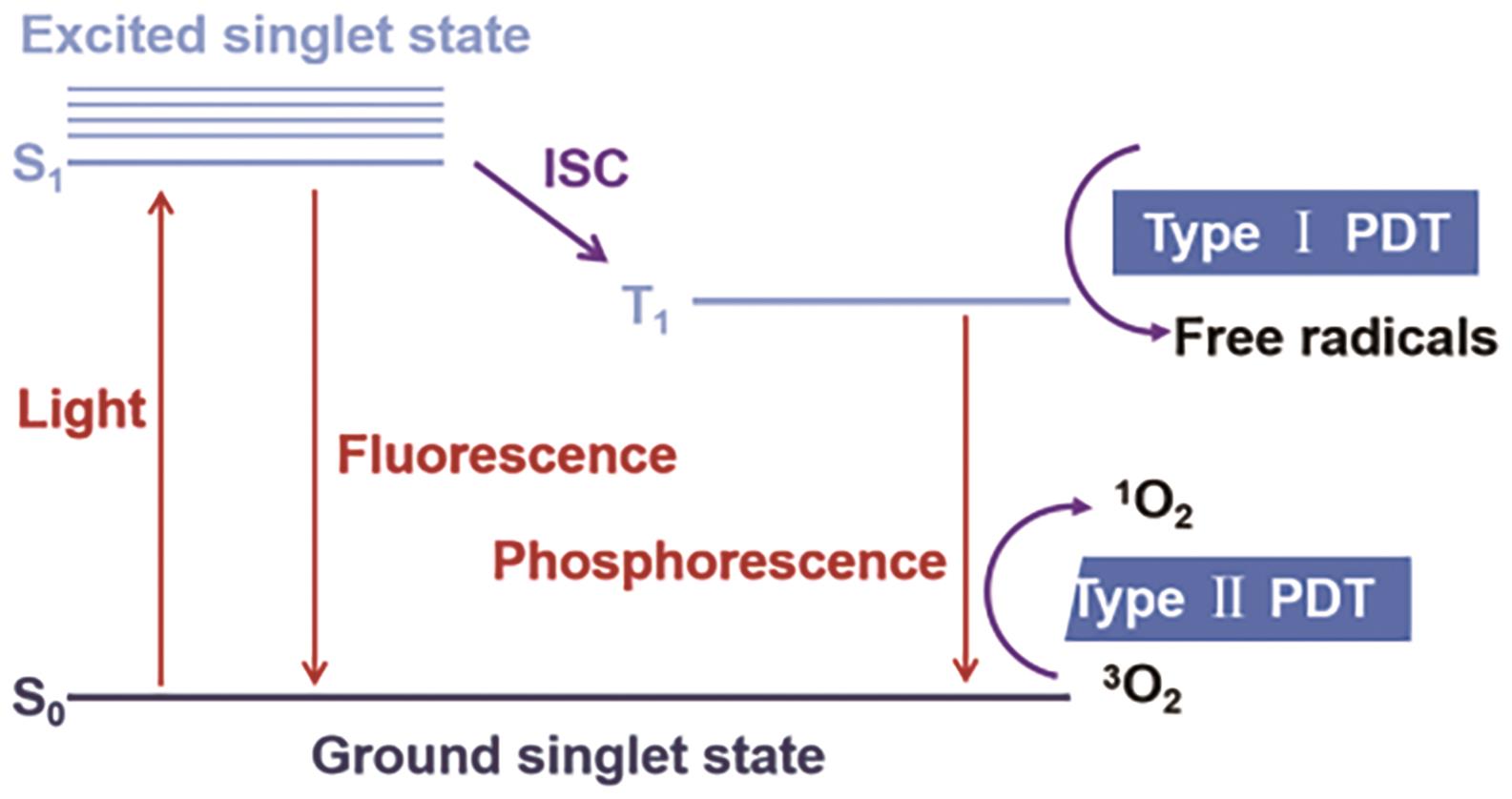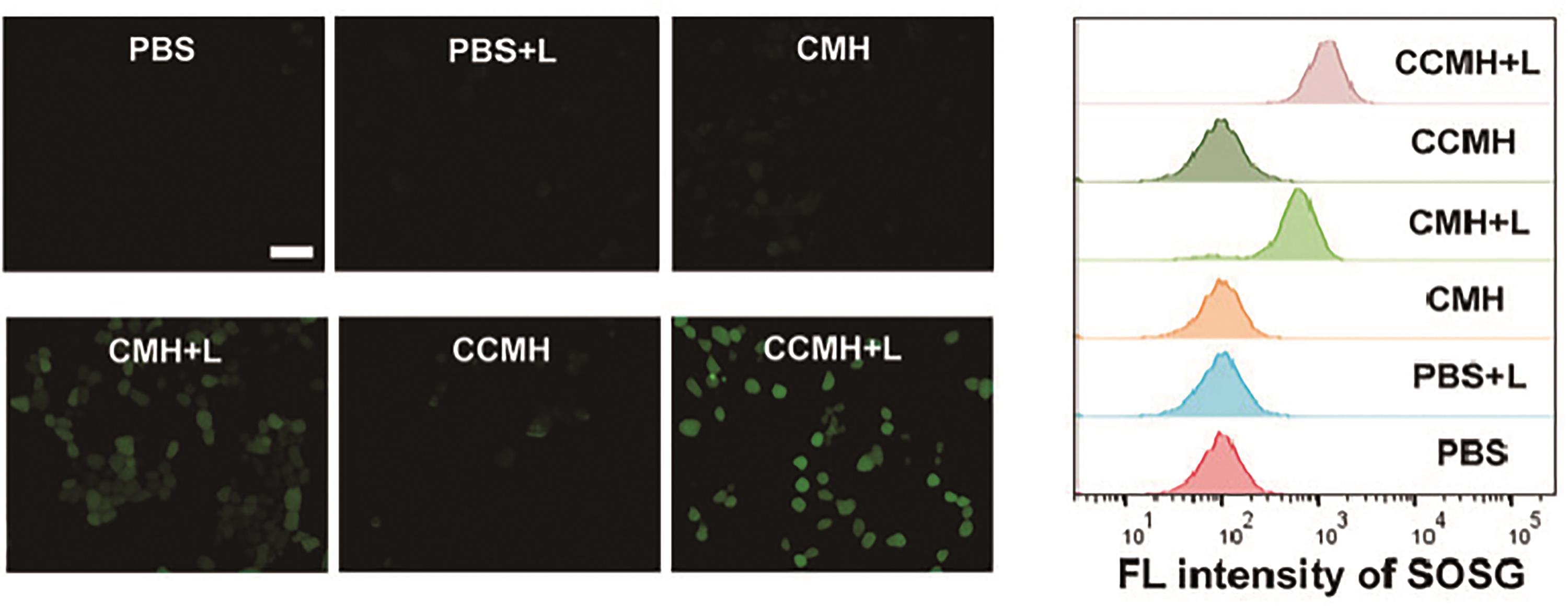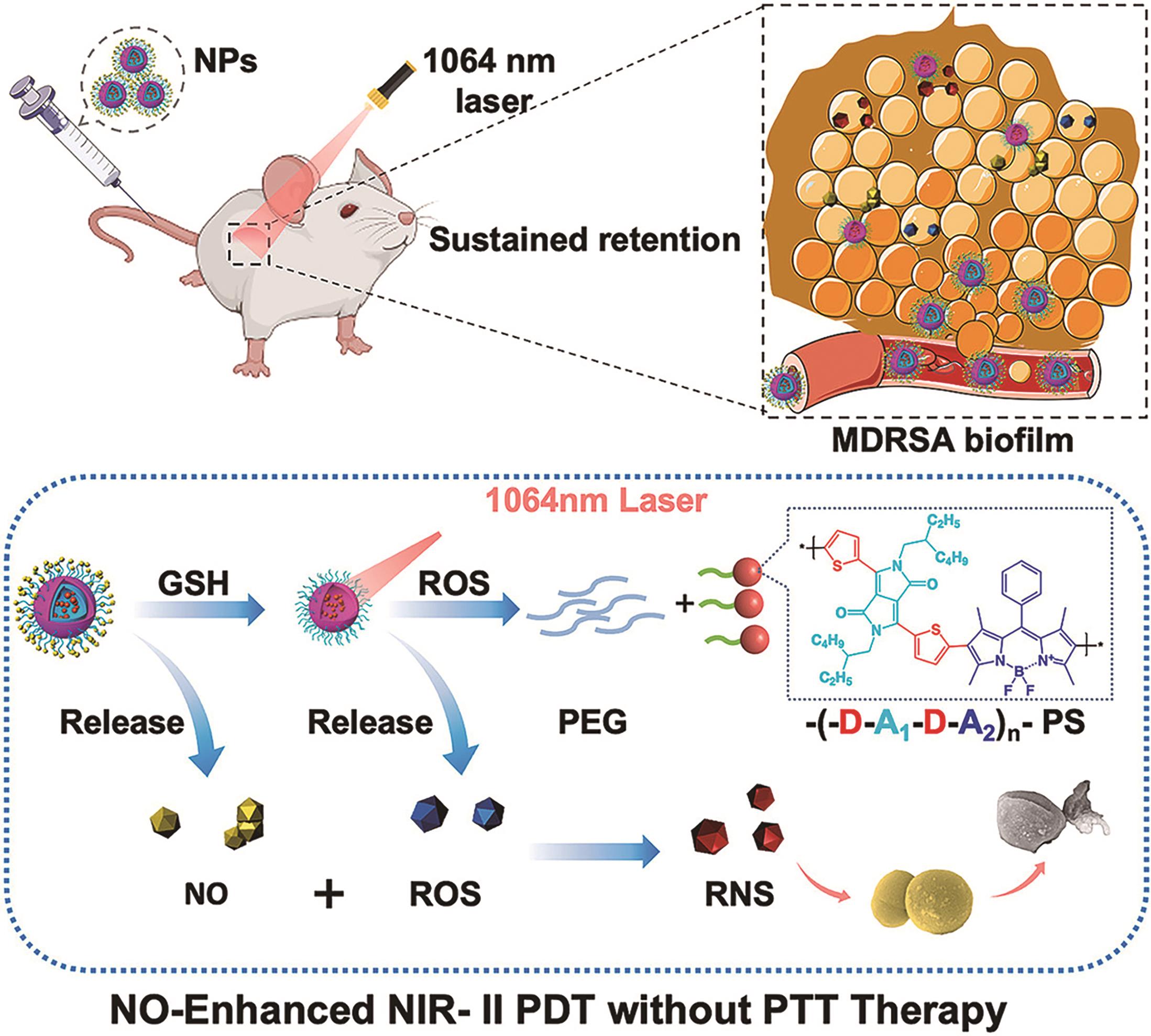
应用化学 ›› 2024, Vol. 41 ›› Issue (7): 925-936.DOI: 10.19894/j.issn.1000-0518.240061
• 综合评述 • 下一篇
近红外二区光驱动的光动力治疗在克服肿瘤乏氧环境中的研究进展
杨懿芊1,2,3, 严晓霞1( ), 彭皓2,3(
), 彭皓2,3( ), 吴爱国2,3, 杨方2,3(
), 吴爱国2,3, 杨方2,3( )
)
- 1.上海大学化学系,上海 200444
2.中国科学院宁波材料技术与工程研究所先进诊疗材料与技术实验室,中国科学院宁波材料技术与工程研究所,宁波 315201
3.先进能源科学与技术广东省实验室,惠州 516000
-
收稿日期:2024-02-29接受日期:2024-04-19出版日期:2024-07-01发布日期:2024-08-03 -
通讯作者:严晓霞,彭皓,杨方 -
基金资助:中国科学院青年创新促进会项目(2022301);宁波市3315创新个人项目(2018-05-G)
Advances of NIR-Ⅱ-Triggered Photodynamic Therapy in Overcoming Tumor Hypoxia Environment
Yi-Qian YANG1,2,3, Xiao-Xia YAN1( ), Hao PENG2,3(
), Hao PENG2,3( ), Ai-Guo WU2,3, Fang YANG2,3(
), Ai-Guo WU2,3, Fang YANG2,3( )
)
- 1.Department of Chemistry,Shanghai University,Shanghai 200444,China
2.Laboratory of Advanced Theranostic Materials and Technology,Ningbo Institute of Materials Technology and Engineering,Chinese Academy of Sciences,Ningbo 315201,China
3.Advanced Energy Science and Technology Guangdong Laboratory,Huizhou 516000,China
-
Received:2024-02-29Accepted:2024-04-19Published:2024-07-01Online:2024-08-03 -
Contact:Xiao-Xia YAN,Hao PENG,Fang YANG -
About author:yangf@nimte.ac.cn
penghao@nimte.ac.cn
xxyan@shu.edu.cn
-
Supported by:the Youth Innovation Promotion Association, Chinese Academy of Sciences(2022301);Ningbo 3315 Innovative Talent Project(2018-05-G)
摘要:
光动力疗法因其具有非侵入性、低毒性、高时空选择性和特异靶向性等独特优势而被广泛应用于肿瘤治疗。该疗法利用光敏剂、光和氧分子,通过光敏剂介导产生活性氧自由基导致氧化损伤选择性地引起靶细胞的凋亡和坏死。然而,传统光动力疗法仍存在一些缺点,如光的组织穿透性有限、分子氧依赖以及肿瘤对治疗的固有障碍,这在很大程度上限制了肿瘤治疗效果。近些年来,国内外科研团队积极开发各种新型光敏剂,并将其与近红外光激发相结合,使得光动力疗法能够更深入地作用于肿瘤组织。针对深层肿瘤组织乏氧环境,进一步采取改善、利用该肿瘤微环境的策略,克服深层肿瘤组织缺氧对光动力疗法的限制,有助于优化肿瘤抑制效果。本文在阐明光动力疗法工作机制的基础上,系统总结讨论了近5年来近红外二区激光激发的光动力疗法在克服肿瘤乏氧障碍的最新进展,包括增加肿瘤组织内部氧含量和通过耐受缺氧环境2种方式针对性开发新型光敏剂,并对其发展前景进行了展望。
中图分类号:
引用本文
杨懿芊, 严晓霞, 彭皓, 吴爱国, 杨方. 近红外二区光驱动的光动力治疗在克服肿瘤乏氧环境中的研究进展[J]. 应用化学, 2024, 41(7): 925-936.
Yi-Qian YANG, Xiao-Xia YAN, Hao PENG, Ai-Guo WU, Fang YANG. Advances of NIR-Ⅱ-Triggered Photodynamic Therapy in Overcoming Tumor Hypoxia Environment[J]. Chinese Journal of Applied Chemistry, 2024, 41(7): 925-936.
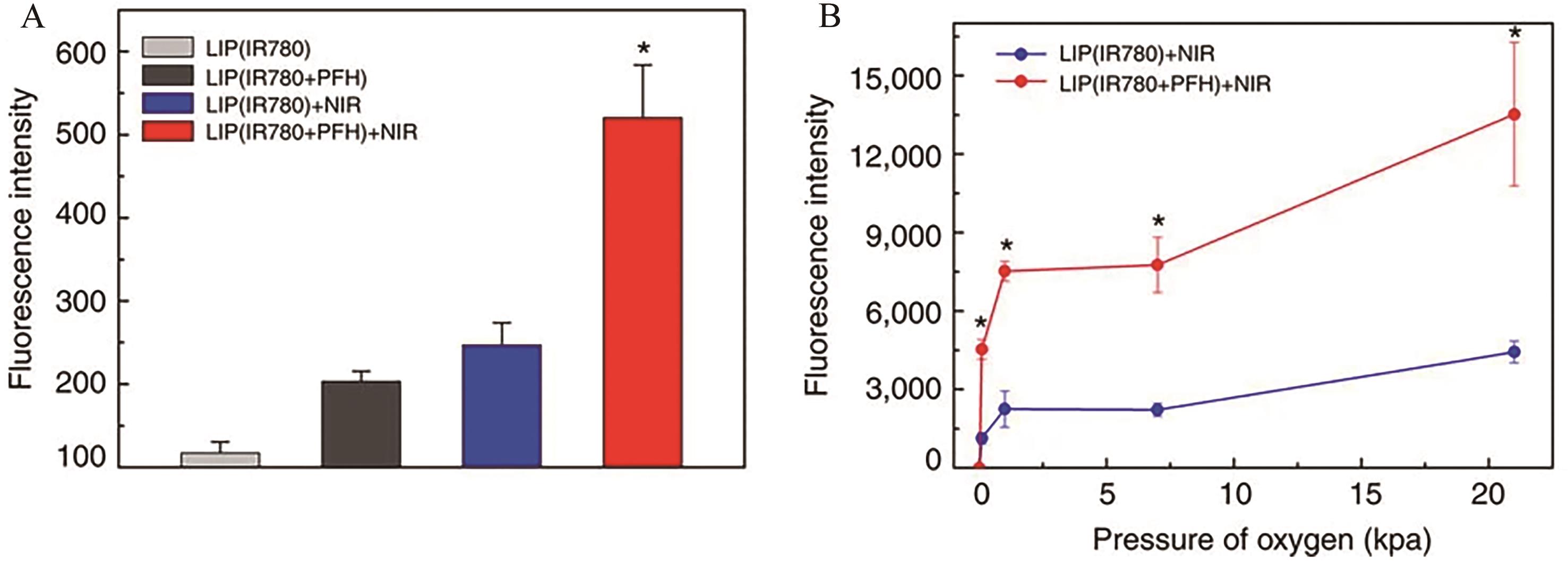
图3 (A) 不同样品在NIR辐照下1O2的产生情况; (B) NIR辐照下不同缺氧状态的1O2产量[35]
Fig.3 (A) 1O2 production of different samples; (B) 1O2 production after irradiation in different hypoxic conditions[35]
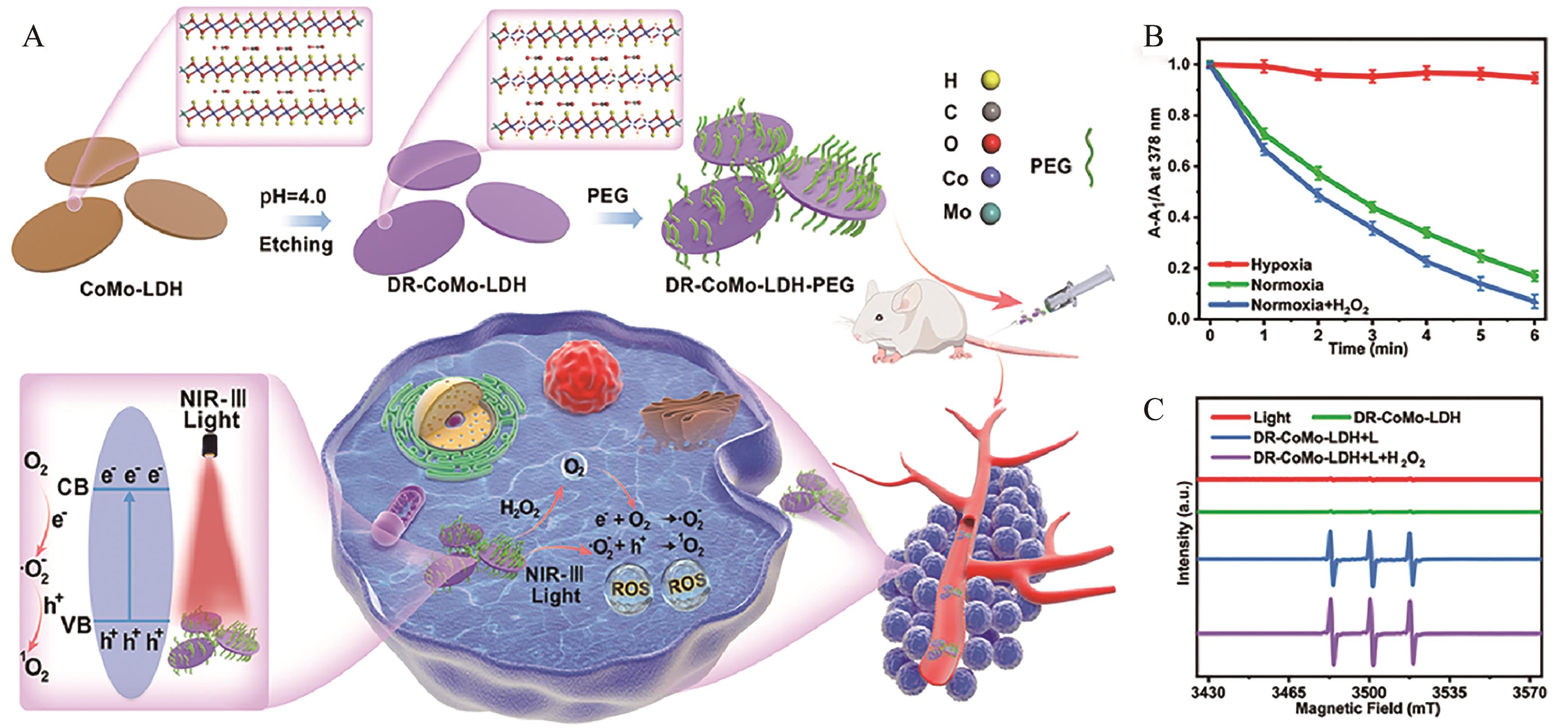
图4 (A) CoMo-LDH纳米片缺陷工程示意图; 通过ABDA衰减情况(B)及ESR光谱图(C)检测CoMo-LDH中1O2的产生情况[48]
Fig.4 (A) Schematic illustration of the defect engineering of CoMo-LDH nanosheets; Identification of 1O2 generation by measuring the absorbance of ABDA in the presence of the CoMo-LDH nanosheets under different environments (B) and ESR spectra of TEMP for the CoMo-LDH nanosheets in different cases (C)[48]

图6 (A) MnO2/Ag3SbS3一体化纳米平台示意图; (B)不同处理下MnO2/Ag3SbS3的GSH耗竭和溶解氧产生情况[59]
Fig.6 (A) Schematic illustration of all-in-one nanoplatform containing MnO2/Ag3SbS3; (B) GSH depletion and O2 generation under different treatments[59]
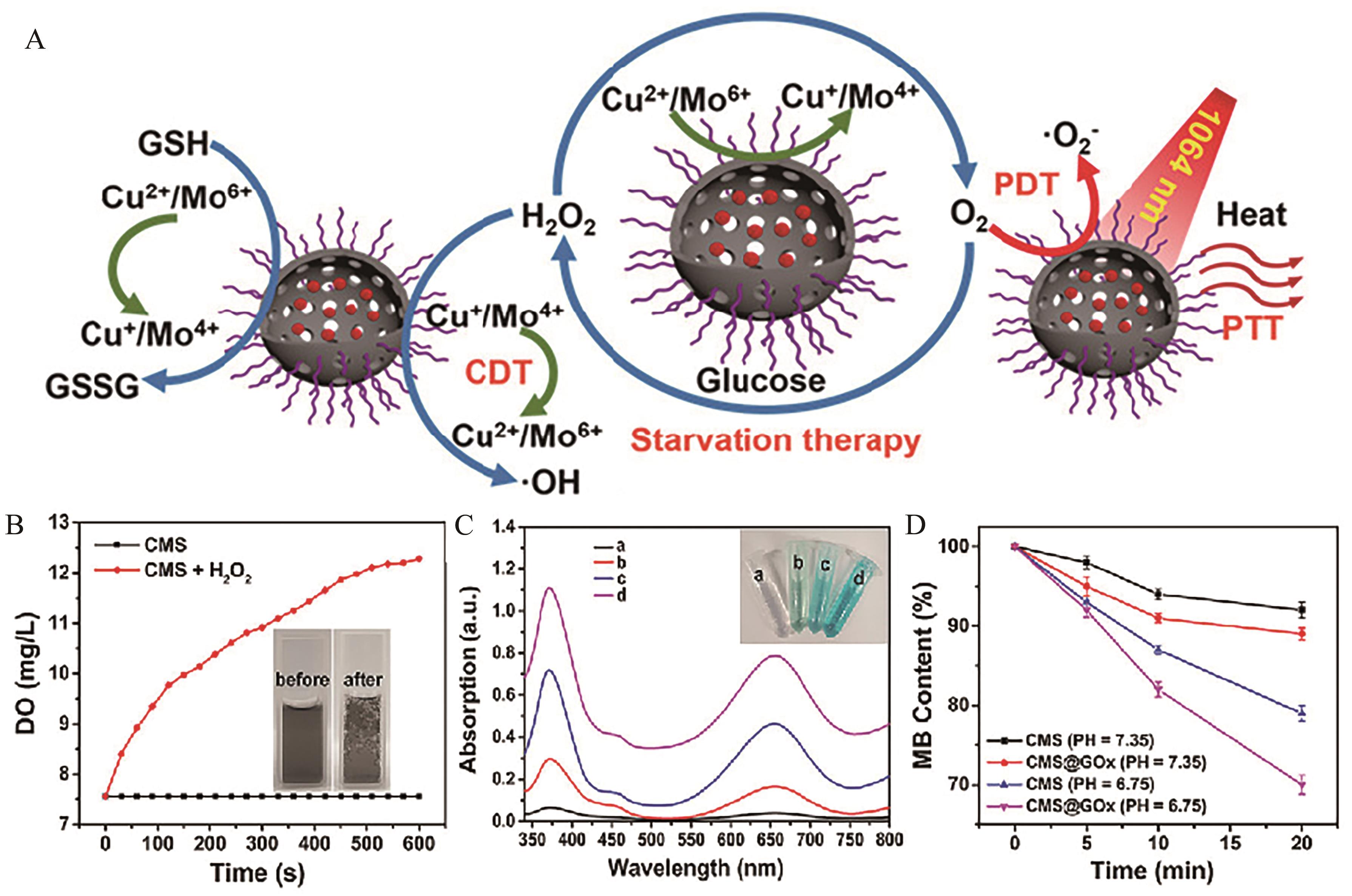
图7 (A) CMS@GOx用于PTT/PDT/CDT/饥饿治疗具体示意图; (B)在不添加和添加H2O2的情况下,CMS溶液中溶解氧的生成曲线; (C)添加不同浓度葡萄糖在CMS@GOx溶液中产生H2O2的具体情况: (a) 0 L, (b) 2×10-3 L, (c) 4×10-3 L, (d) 8×10-3 L; (D)不同反应条件下·OH生成情况[65]
Fig.7 (A) Schematic illustration of mechanism of CMS@GOx for PTT/PDT/CDT/starvation therapy; (B) The generation of dissolved O2 in CMS aqueous solution without and with H2O2 addition; (C) H2O2 generation in CMS@GOx solution arising from the addition of different concentrations of glucose: (a) 0 L, (b) 2×10-3 L, (c) 4×10-3 L, (d) 8×10-3 L; (D) Generation of ·OH over CMS or CMS@GOx under different treatments[65]
| 1 | LIANG X, CHEN M, BHATTARAI P, et al. Complementing cancer photodynamic therapy with ferroptosis through iron oxide loaded porphyrin-grafted lipid nanoparticles[J]. ACS Nano, 2021, 15: 20164-20180. |
| 2 | TAO W, WANG N, RUAN J, et al. Enhanced ROS-boosted phototherapy against pancreatic cancer via Nrf2-mediated stress-defense pathway suppression and ferroptosis induction[J]. ACS Appl Mater Interfaces, 2022, 14: 6404-6416. |
| 3 | HOU H, HUANG X, WEI G, et al. Fenton reaction-assisted photodynamic therapy for cancer with multifunctional magnetic nanoparticles[J]. ACS Appl Mater Interfaces, 2019, 11: 29579-29592. |
| 4 | DAI H, WANG X, SHAO J, et al. NIR-Ⅱ organic nanotheranostics for precision oncotherapy[J]. Small, 2021, 17: e2102646. |
| 5 | XUE E Y, YANG C, FONG W P, et al. Site-specific displacement-driven activation of supramolecular photosensitizing nanoassemblies for antitumoral photodynamic therapy[J]. ACS Appl Mater Interfaces, 2022, 14: 14903-14915. |
| 6 | CUI D, LI J, ZHAO X, PU K, et al. Semiconducting polymer nanoreporters for near-infrared chemiluminescence imaging of immunoactivation[J]. Adv Mater, 2020, 32: e1906314. |
| 7 | XIE J, WANG Y, CHOI W, et al. Overcoming barriers in photodynamic therapy harnessing nano-formulation strategies[J]. Chem Soc Rev, 2021, 50: 9152-9201. |
| 8 | JI B, WEI M, YANG B. Recent advances in nanomedicines for photodynamic therapy (PDT)-driven cancer immunotherapy[J]. Theranostics, 2022, 12: 434-458. |
| 9 | LI X L, JIANG C, JIA X L, et al. Dual “unlocking” strategy to overcome inefficient nanomedicine delivery and tumor hypoxia for enhanced photodynamic-immunotherapy[J]. Adv Healthc Mater, 2023, 12(6): e2202467. |
| 10 | HAN K, ZHANG J, ZHANG W, et al. Tumor-triggered geometrical shape switch of chimeric peptide for enhanced in vivo tumor internalization and photodynamic therapy[J]. ACS Nano, 2017, 11: 3178-3188. |
| 11 | ZHAO X, LIU J, FAN J, et al. Recent progress in photosensitizers for overcoming the challenges of photodynamic therapy: from molecular design to application[J]. Chem Soc Rev, 2021, 50(6): 4185-4219. |
| 12 | FAN W, HUANG P, CHEN X. Overcoming the Achilles' heel of photodynamic therapy[J]. Chem Soc Rev, 2016, 45(23): 6488-6519. |
| 13 | SUN B, BTE RAHMAT J N, ZHANG Y. Advanced techniques for performing photodynamic therapy in deep-seated tissues[J]. Biomaterials, 2022, 291: 121875. |
| 14 | ZHOU Z, SONG J, NIE L, et al. Reactive oxygen species generating systems meeting challenges of photodynamic cancer therapy[J]. Chem Soc Rev, 2016, 45(23): 6597-6626. |
| 15 | HAN K, MA Z, HAN H. Functional peptide-based nanoparticles for photodynamic therapy[J]. J Mater Chem B, 2018, 6: 25-38. |
| 16 | SHI T, HUANG C, LI Y, et al. NIR-Ⅱ phototherapy agents with aggregation-induced emission characteristics for tumor imaging and therapy[J]. Biomaterials, 2022, 285: 121535. |
| 17 | LI X, ZHAO Z, ZHANG M, et al. Research progress of microneedles in the treatment of melanoma[J]. J Control Release, 2022, 348: 631-647. |
| 18 | ZHOU J Y, WANG W J, ZHANG C Y, et al. Ru(Ⅱ)-modified TiO2 nanoparticles for hypoxia-adaptive photo-immunotherapy of oral squamous cell carcinoma[J]. Biomaterials, 2022, 289: 121757. |
| 19 | JIANG Y, ZHAO X, HUANG J, et al. Transformable hybrid semiconducting polymer nanozyme for second near-infrared photothermal ferrotherapy[J]. Nat Commun, 2020, 11: 1857. |
| 20 | QIAN Y, WANG J L, BU W B, et al. Targeted implementation strategies of precise photodynamic therapy based on clinical and technical demands[J]. Biomater Sci, 2023, 11: 704-718. |
| 21 | ZHANG C, HU X, JIN L, et al. Strategic design of conquering hypoxia in tumor for advanced photodynamic therapy[J]. Adv Healthc Mater, 2023, 12(24): e2300530. |
| 22 | GENG B, YAN L, ZHU Y, et al. Carbon dot@MXene nanozymes with triple enzyme-mimic activities for mild NIR-Ⅱ photothermal-amplified nanocatalytic therapy[J]. Adv Healthc Mater, 2023, 12(5): e2202154. |
| 23 | ZHOU Z H, HUANG J S, ZHANG Z Y, et al. Bimetallic PdPt-based nanocatalysts for photothermal-augmented tumor starvation and sonodynamic therapy in NIR-Ⅱ biowindow assisted by an oxygen self-supply strategy[J]. Chem Eng J, 2022, 435(2): 135085. |
| 24 | YANG Y, CHEN M, WANG B, et al. NIR-Ⅱ driven plasmon-enhanced catalysis for a timely supply of oxygen to overcome hypoxia-induced radiotherapy tolerance[J]. Angew Chem Int Ed, 2019, 58: 15069-15075. |
| 25 | LIU Y, JIANG Y, ZHANG M, et al. Modulating hypoxia via nanomaterials chemistry for efficient treatment of solid tumors[J]. Acc Chem Res, 2018, 51(10): 2502-2511. |
| 26 | JIANG L Y, BAI H T, LIU L B, et al. Luminescent, oxygen-supplying, hemoglobin-linked conjugated polymer nanoparticles for photodynamic therapy[J]. Angew Chem Int Ed, 2019, 58: 10660-10665. |
| 27 | ZHANG F, ZHANG B, WANG Y Y, et al. An extra-erythrocyte role of haemoglobin body in chondrocyte hypoxia adaption[J]. Nature, 2023, 622(7984): 834-841. |
| 28 | KIM H, YOON J, KIM H K, et al. Upconverting nanoparticle-containing erythrocyte-sized hemoglobin microgels that generate heat, oxygen and reactive oxygen species for suppressing hypoxic tumors[J]. Bioact Mater, 2023, 22: 112-126. |
| 29 | DING L, WU Y N, WU M, et al. Engineered red blood cell biomimetic nanovesicle with oxygen self-supply for near-infrared-Ⅱ fluorescence-guided synergetic chemo-photodynamic therapy against hypoxic tumors[J]. ACS Appl Mater Interfaces, 2021, 13: 52435-52449. |
| 30 | LIU F R, HE T, GONG S L, et al. A tumor pH-responsive autocatalytic nanoreactor as a H2O2 and O2 self-supplying depot for enhanced ROS-based chemo/photodynamic therapy[J]. Acta Biomater, 2022, 154: 510-522. |
| 31 | WANG H R, GUO Y F, WANG C, et al. Light-controlled oxygen production and collection for sustainable photodynamic therapy in tumor hypoxia[J]. Biomaterials, 2021, 269: 120621. |
| 32 | ZHANG Y F, BO S W, FENG T, et al. A Versatile theranostic nanoemulsion for architecture-dependent multimodal imaging and dually augmented photodynamic therapy[J]. Adv Mater, 2019, 31(21): e1806444. |
| 33 | ZHANG Y F, LIAO Y Y, TANG Q N, et al. Biomimetic nanoemulsion for synergistic photodynamic-immunotherapy against hypoxic breast tumor[J]. Angew Chem Int Ed, 2021, 60: 10647-10653. |
| 34 | ZHANG S, LI Z, WANG Q, et al. An NIR-Ⅱ photothermally triggered “oxygen bomb” for hypoxic tumor programmed cascade therapy[J]. Adv Mater, 2022, 34: e2201978. |
| 35 | CHENG Y H, CHENG H, JIANG C X, et al. Perfluorocarbon nanoparticles enhance reactive oxygen levels and tumour growth inhibition in photodynamic therapy[J]. Nat Commun, 2015, 6: 8785. |
| 36 | WANG W, CHENG Y, YU P, et al. Perfluorocarbon regulates the intratumoural environment to enhance hypoxia-based agent efficacy[J]. Nat Commun, 2019, 10(1): 1580. |
| 37 | NAVYA P N, MEHLA S, BEGUM A, et al. Smart nanozymes for cancer therapy: the next frontier in oncology[J]. Adv Healthc Mater, 2023, 12(25): e2300768. |
| 38 | CHEN X, QIU M J, LIU L P, et al. Intelligent Bi2Se3@Cu2- xSe heterostructures with enhanced photoabsorption and photoconversion efficiency for tri-modal imaging guided combinatorial cancer therapy by near-infrared Ⅱ light[J]. J Colloid Interface Sci, 2022, 625: 614-627. |
| 39 | LIU C, XING J, AKAKURU O U, LUO L J, et al. Nanozymes-engineered metal-organic frameworks for catalytic cascades-enhanced synergistic cancer therapy[J]. Nano Lett, 2019, 19: 5674-5682. |
| 40 | LI Q, WU T T, FAN X W, et al. Multifaceted nanozymes for synergistic antitumor therapy: a review[J]. Mater Des, 2022, 224: 111430. |
| 41 | WANG L M, KANG K K, HOU H Y, et al. NIR-Ⅱ-driven intracellular photocatalytic oxygen-generation on Z-scheme iron sulfide/cobalt sulfide nanosheets for hypoxic tumor therapy[J]. J Colloid Interface Sci, 2022, 625: 145-157. |
| 42 | HUANG Y, REN J, QU X. Nanozymes: classification, catalytic mechanisms, activity regulation, and applications[J]. Chem Rev, 2019, 119(6): 4357-4412. |
| 43 | XU D, WU L, YAO H, et al. Catalase-like nanozymes: classification, catalytic mechanisms, and their applications[J]. Small, 2022, 18(37): e2203400. |
| 44 | ZHANG R, CHEN L, LIANG Q, et al. Unveiling the active sites on ferrihydrite with apparent catalase-like activity for potentiating radiotherapy[J]. Nano Today, 2021, 41: 101317. |
| 45 | ZHU Y, WANG Y J, WILLIAMS G R, et al. Multicomponent transition metal dichalcogenide nanosheets for imaging-guided photothermal and chemodynamic therapy[J]. Adv Sci, 2020, 7(23): 2000272. |
| 46 | YAN L, WANG Y J, HU T T, et al. Layered double hydroxide nanosheets: towards ultrasensitive tumor microenvironment responsive synergistic therapy[J]. J Mater Chem B, 2020, 8: 1445-1455. |
| 47 | HU T T, YAN L, WANG Z D, et al. A pH-responsive ultrathin Cu-based nanoplatform for specific photothermal and chemodynamic synergistic therapy[J]. Chem Sci, 2021, 12: 2594-2603. |
| 48 | SHEN W C, HU T T, LIU X Y, et al. Defect engineering of layered double hydroxide nanosheets as inorganic photosensitizers for NIR-Ⅲ photodynamic cancer therapy[J]. Nat Commun, 2022, 13(1): 3384. |
| 49 | WANG H, ZHAO Y, LI T, et al. Properties of calcium peroxide for release of hydrogen peroxide and oxygen: a kinetics study[J]. Chem Eng J, 2016, 303: 450-457. |
| 50 | RASTINFARD A, NAZARPAK M H, MOZTARZADEH F. Controlled chemical synthesis of CaO2 particles coated with polyethylene glycol: characterization of crystallite size and oxygen release kinetics[J]. RSC Adv, 2018, 8: 91-101. |
| 51 | KHODAVEISI J, BANEJAD H, AFKHAMI A, et al. Synthesis of calcium peroxide nanoparticles as an innovative reagent for in situ chemical oxidation[J]. J Hazard Mater, 2011, 192: 1437-1440. |
| 52 | LI W L, XIN H, ZHANG Y N, et al. NIR-Ⅱ fluorescence imaging-guided oxygen self-sufficient nano-platform for precise enhanced photodynamic therapy[J]. Small, 2022, 18(51): e2205647. |
| 53 | XIAO Y P, LI Z, BIANCO A, et al. Recent advances in calcium-based anticancer nanomaterials exploiting calcium overload to trigger cell apoptosis[J]. Adv Funct Mater, 2022, 33(3): 2209291. |
| 54 | HUANG C, LIN B Q, CHEN C Y, et al. Synergistic reinforcing of immunogenic cell death and transforming tumor-associated macrophages via a multifunctional cascade bioreactor for optimizing cancer immunotherapy[J]. Adv Mater, 2022, 34(51): e2207593. |
| 55 | YANG B, ZHANG Y, SUN L, et al. Modulated ultrasmall γ-Fe2O3 nanocrystal assemblies for switchable magnetic resonance imaging and photothermal-ferroptotic-chemical synergistic cancer therapy[J]. Adv Funct Mater, 2022, 33(5): 2211251. |
| 56 | XIONG H, WANG C, WANG Z, et al. Intracellular cascade activated nanosystem for improving ER+ breast cancer therapy through attacking GSH-mediated metabolic vulnerability[J]. J Control Release, 2019, 309: 145-157. |
| 57 | XU W, WANG T, QIAN J, et al. Fe(Ⅱ)-hydrazide coordinated all-active metal organic framework for photothermally enhanced tumor penetration and ferroptosis-apoptosis synergistic therapy[J]. Chem Eng J, 2022, 437:135311. |
| 58 | YANG Y, WANG P, SHI R, et al. Design of the tumor microenvironment-multiresponsive nanoplatform for dual-targeting and photothermal imaging guided photothermal/photodynamic/chemodynamic cancer therapies with hypoxia improvement and GSH depletion[J]. Chem Eng J, 2022, 441: 136042. |
| 59 | WANG Q, QU B T, LI J, et al. Multifunctional MnO2/Ag3SbS3 nanotheranostic agent for single-laser-triggered tumor synergistic therapy in the NIR-Ⅱ biowindow[J]. ACS Appl Mater Interfaces, 2022, 14: 4980-4994. |
| 60 | WANG Y, LI Y, ZHANG Z, et al. Triple-jump photodynamic theranostics: MnO2 combined upconversion nanoplatforms involving a type-Ⅰ photosensitizer with aggregation-induced emission characteristics for potent cancer treatment[J]. Adv Mater, 2021, 33(41): e2103748. |
| 61 | HAO H J, SUN M M, LI P Y, et al. In situ growth of a cationic polymer from the N-terminus of glucose oxidase to regulate H2O2 generation for cancer starvation and H2O2 therapy[J]. ACS Appl Mater Interfaces, 2019, 11: 9756-9762. |
| 62 | ZHANG H W, LU F, PAN W, et al. A dual-catalytic nanoreactor for synergistic chemodynamic-starvation therapy toward tumor metastasis suppression[J]. Biomater Sci, 2021, 9: 3814-3820. |
| 63 | YU Z Z, ZHOU P, PAN W, et al. A biomimetic nanoreactor for synergistic chemiexcited photodynamic therapy and starvation therapy against tumor metastasis[J]. Nat Commun, 2018, 9(1): 5044. |
| 64 | WU J Y Z, ZHANG Y F, JIANG K J, et al. Enzyme-engineered conjugated polymer nanoplatform for activatable companion diagnostics and multistage augmented synergistic therapy[J]. Adv Mater, 2022, 34(18): e2200062. |
| 65 | CHANG M, WANG M, WANG M, et al. A multifunctional cascade bioreactor based on hollow-structured Cu2MoS4 for synergetic cancer chemo-dynamic therapy/starvation therapy/phototherapy/immunotherapy with remarkably enhanced efficacy[J]. Adv Mater, 2019, 31: e1905271. |
| 66 | LV Z J, JIN L H, GAO W H, et al. Novel YOF-based theranostic agents with a cascade effect for NIR-Ⅱ fluorescence imaging and synergistic starvation/photodynamic therapy of orthotopic gliomas[J]. ACS Appl Mater Interfaces, 2022, 14: 30523-30532. |
| 67 | GAO X, FENG J, SONG S Y, et al. Tumor-targeted biocatalyst with self-accelerated cascade reactions for enhanced synergistic starvation and photodynamic therapy[J]. Nano Today, 2022, 43: 101433. |
| 68 | LI X L, JIANG C, WANG Q H, et al. A “valve-closing” starvation strategy for amplification of tumor-specific chemotherapy[J]. Adv Sci, 2022, 9(8): e2104671. |
| 69 | SZABO C. Gasotransmitters in cancer: from pathophysiology to experimental therapy[J]. Nat Rev Drug Discov, 2016, 15: 185-203. |
| 70 | WANG Y S, YANG T, HE Q J. Strategies for engineering advanced nanomedicines for gas therapy of cancer[J]. Natl Sci Rev, 2020, 7: 1485-1512. |
| 71 | WANG K Y, LI Y, WANG X, et al. Gas therapy potentiates aggregation-induced emission luminogen-based photoimmunotherapy of poorly immunogenic tumors through cGAS-STING pathway activation[J]. Nat Commun, 2023, 14(1): 2950. |
| 72 | JI P, YANG K X, XU Q Q, et al. Mechanisms and application of gas-based anticancer therapies[J]. Pharmaceuticals-Base, 2023, 16(10): 1394. |
| 73 | JIANG J, XIE J, ZHOU L, et al. Near infrared responsive nitric oxide and carbon monoxide nanoplatform for synergistic photodynamic therapy against periodontitis[J]. Chem Eng J, 2024, 480: 147850. |
| 74 | CHANG M, WANG M, LIU Y, et al. Dendritic plasmonic CuPt alloys for closed-loop multimude cancer therapy with remarkably enhanced efficacy[J]. Small, 2022, 19: e2206423. |
| 75 | LUO G H, LI Z H, CHEN M L, et al. Three-staged tumor inhibition by mitochondria-targeted cascaded gas/mild-photothermal/photodynamic synergistic therapy[J]. Chem Eng J, 2022, 442: 136169. |
| 76 | LIU F R, GONG S L, SHEN M L, et al. A glutathione-activatable nanoplatform for enhanced photodynamic therapy with simultaneous hypoxia relief and glutathione depletion[J]. Chem Eng J, 2021, 403: 126305. |
| 77 | LI M, ZHAO M, ZHANG Y J, et al. Second near-infrared light-activated semiconducting polymer nanomediators enable three-in-one tumor microenvironment modulation for combination immunotherapy[J]. Nano Today, 2023, 50: 101833. |
| 78 | BU F Q, KANG X X, TANG D S, et al. Enhancing near-infrared Ⅱ photodynamic therapy with nitric oxide for eradicating multidrug-resistant biofilms in deep tissues[J]. Bioact Mater, 2024, 33: 341-354. |
| 79 | WANG Z X, ZHAN M X, LI W J, et al. Photoacoustic cavitation-ignited reactive oxygen species to amplify peroxynitrite burst by photosensitization-free polymeric nanocapsules[J]. Angew Chem Int Ed, 2021, 60: 4720-4731. |
| 80 | WANG R, XIA X, YANG Y J, et al. A glutathione activatable photosensitizer for combined photodynamic and gas therapy under red light irradiation[J]. Adv Healthc Mater, 2022, 11(4): e2102017. |
| 81 | ZHANG T F, PAN Y, SUO M, et al. Photothermal-triggered sulfur oxide gas therapy augments type Ⅰ photodynamic therapy for potentiating cancer stem cell ablation and inhibiting radioresistant tumor recurrence[J]. Adv Sci, 2023, 10(29): e2304042. |
| 82 | ZHANG Y, SHEN W, ZHANG P, et al. GSH-triggered release of sulfur dioxide gas to regulate redox balance for enhanced photodynamic therapy[J]. Chem Commun, 2020, 56: 5645-5648. |
| 83 | LIU Z, FENG Z, CHEN M, et al. An orthogonally activatable CRISPR-Cas13d nanoprodrug to reverse chemoresistance for enhanced chemo-photodynamic therapy[J]. Chem Sci, 2023, 14: 4102-4113. |
| 84 | CHAI X, YI D, SHENG C, et al. A remotely controlled nanosystem for spatiotemporally specific gene regulation and combinational tumor therapy[J]. Angew Chem Int Ed, 2023, 62: e202217702. |
| 85 | LI Q, FAN H, XU Y, et al. NIR-responsive hollow germanium nanospheres mediate photothermal/photodynamic therapy and restrain immunosuppression to cooperatively eradicate primary and metastatic tumors[J]. Chem Eng J, 2023, 458: 141314. |
| 86 | WAN G, CHEN X, CHEN J, et al. Endoplasmic reticulum-targeted NIR-Ⅱ phototherapy combined with inflammatory vascular suppression elicits a synergistic effect against TNBC[J]. Biomater Sci, 2023, 11: 1876-1894. |
| [1] | 李英维, 韩吉, 关卜源. 二维介孔材料的合成方法、设计与应用研究进展[J]. 应用化学, 2024, 41(6): 767-782. |
| [2] | 彭孔浩, 白安琪, 孟颖, 殷慧, 宿欣瑶, 杨金玉, 李淑荣, 张凌燕, 罗利霞, 孟佩俊. 纳米材料传感器在有机磷农药残留检测中的研究进展[J]. 应用化学, 2024, 41(4): 472-483. |
| [3] | 尹娜, 王樱蕙, 张洪杰. 稀土纳米材料在脑肿瘤成像和治疗中的研究进展[J]. 应用化学, 2024, 41(3): 309-327. |
| [4] | 赵欣雨, 秦作佳, 张晓兵, 袁林. 近红外二区激活型小分子荧光探针研究进展[J]. 应用化学, 2024, 41(1): 39-59. |
| [5] | 卢剑天, 邹金辉, 赵博霖, 张玉微. 无机纳米酶在分析传感领域的应用研究进展[J]. 应用化学, 2024, 41(1): 60-86. |
| [6] | 谭翠盈, 丁威超, 马婷婷, 肖瑶, 刘健. 超亲水/超疏气电解水催化剂的研究进展[J]. 应用化学, 2023, 40(8): 1109-1125. |
| [7] | 王超宇, 赵璐, 王科伟, 白云峰, 冯锋. 共价有机框架的构筑策略及其在肿瘤治疗中应用的研究进展[J]. 应用化学, 2023, 40(7): 976-994. |
| [8] | 李慧慧, 姚开胜, 赵亚南, 范李娜, 田钰琳, 卢伟伟. 离子液体调控合成Pt-Pd双金属纳米材料及其催化氨硼烷水解释氢[J]. 应用化学, 2023, 40(4): 597-609. |
| [9] | 柳小虎, 赖小娟, 曹红燕, 王婷婷, 党志强. 起泡剂/稳泡剂/SiO2复合泡沫缓速酸液体系协同增效性能[J]. 应用化学, 2023, 40(1): 91-99. |
| [10] | 张松涛, 王樱蕙, 张洪杰. Nd3+离子敏化的荧光纳米探针用于近红外二区血管成像[J]. 应用化学, 2022, 39(4): 685-693. |
| [11] | 杜慧, 姚晨阳, 彭皓, 姜波, 李顺祥, 姚俊烈, 郑方, 杨方, 吴爱国. 过渡金属掺杂磁性纳米粒子在生物医学领域中的研究进展[J]. 应用化学, 2022, 39(3): 391-406. |
| [12] | 赵春梅, 周秀苗, 金茜茜, 王雨杭, 党祎静. 基于马鞍形环八四噻吩的复合纳米材料的制备及发光性能[J]. 应用化学, 2022, 39(02): 283-288. |
| [13] | 黄晓桐, 陈颖欣, 朱泽滨, 周丽华. 基于纳米材料光谱分析法检测抗坏血酸的研究进展[J]. 应用化学, 2021, 38(6): 637-650. |
| [14] | 刘娇, 邹鹏飞, 李平, 张潇, 王欣欣, 高媛媛, 李莉莉. 多肽类自组装纳米材料对抗细菌耐药的研究进展[J]. 应用化学, 2021, 38(5): 546-558. |
| [15] | 周莹, 刘赛男, 蔡砺寒, 张健夫, 逄茂林. 铁掺杂的聚2-硝基-1,4-苯二胺纳米球的制备及在光热/光动力/化学动力学肿瘤治疗中的应用[J]. 应用化学, 2021, 38(2): 0-0. |
| 阅读次数 | ||||||
|
全文 |
|
|||||
|
摘要 |
|
|||||
